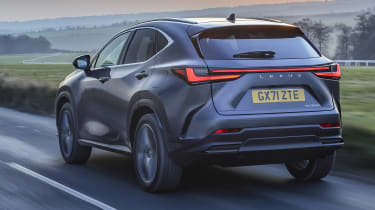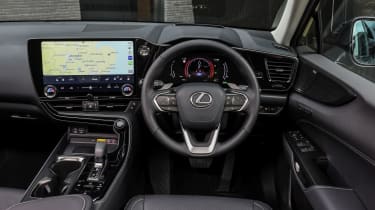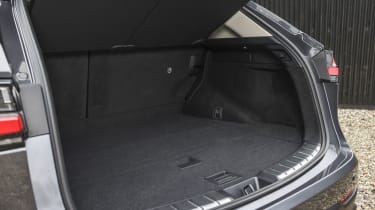Lexus NX 350h hybrid review
There’s a lot to like about the new Lexus NX hybrid, including refinement and cabin quality that are up there with the very best in the premium SUV class
Pros
- Great refinement
- Exceptional interior quality
- Cheaper than plug-in version
Cons
- CVT gearbox
- Plug-in model is far more efficient
- Company-car tax higher than plug-in’s
| Car type | Fuel economy | CO2 emissions | 0-62mph |
|---|---|---|---|
| Hybrid | 44mpg | 136g/km | 7.7s |
Lexus introduced its first fully electric car – the UX 300e – in 2021 and its first plug-in hybrid – the NX 450h+ – followed in early 2022. But traditional "self-charging" hybrids have been part of the Japanese carmaker’s range for many years, with the majority of its models now available exclusively with this powertrain. The latest is this: the new NX 350h. It replaces the outgoing NX 300h – Lexus’ best-selling model in the UK for many years.
We’ve already driven the slightly more expensive plug-in hybrid version of the NX, which should draw the attention of company-car drivers thanks to its class-leading efficiency, great refinement and an impressive electric range. Now, we’ve taken the full-hybrid NX 350h out on UK roads to see if it offers an equally appealing package, particularly for those unable to regularly charge the plug-in model at home or work.
Around town, the full-hybrid NX manages its two power sources remarkably well, highlighting Lexus’ near-20-year history of producing hybrids. The electrified SUV is almost always silent at slow speeds, meaning refinement comes close to matching the latest pure-electric cars.
The only occasion it’s not quite EV-like is when you unintentionally find yourself sitting with the ignition on while waiting in traffic and the engine fires up. But the NX still returns diesel-topping efficiency, and it also rides very well, with the suspension preventing any nasty shocks or potholes disturbing you. All-in-all, the hybrid system’s refinement makes life simple around town.
Cruising on the motorway is a cinch, too. However, pushing the accelerator does send the revs soaring due to the not-so-flawless CVT gearbox. That doesn’t mean the Lexus falls flat on its face when you encounter some twistier roads; the sophisticated damping ensures it remains almost completely flat during fast cornering. A BMW X3 is still more fun to drive, however.
Only a little feedback makes its way through the wheel, but the steering is at least precise. Grip from the E-Four all-wheel-drive system of our test car was good, too. The entry-level version is front-wheel-drive only, and comes in around £1,000 less than an all-wheel-drive version.
What’s more impressive is the interior. The NX’s cabin has been modelled around the ‘Tazuma’ philosophy, whereby everything should fall to hand or sit within your eyeline. And it works well in practice, with the raised centre console bringing many of the most frequently used controls to hand height. Plus, there’s a shortcut bar on the screen and big rotary dials for the climate controls. We did struggle to locate the heated-seat controls at first, eventually discovering them hidden within one of the infotainment sub-menus.
Speaking of which, the entry-level version, simply called ‘NX’, gets a 9.8-inch central infotainment screen with Apple and Android connectivity. But stepping up to at least the Premium Pack gives you the option of the 14-inch unit found in our test car. Forget the clunky Lexus infotainment systems of old: this new system is crisp, clear and even quite intuitive. The fiddly trackpad has also been tossed away in favour of a responsive, easy-to-operate touchscreen.
Cabin quality overall is top-notch. You can always rely on Lexus to fit soft, squishy fabrics to the dashboard and doors, but it’s the way everything in the NX feels so impeccably screwed-together that makes it stand out from its German and Swedish rivals. Frankly, the 350h may well set the new premium family SUV benchmark in this area.
Practicality is good, too. There’s a decent amount of space in the rear, even for taller adults, and you get 520 litres of boot space, with some underfloor storage that’s ideal for keeping valuables out of sight. However, there aren’t any levers to fold the seats down from the boot, which isn’t great. It’s also worth noting that the full-hybrid 350h doesn’t have any more boot space than the plug-in hybrid 450h+ – compared to the BMW X3, where the plug-in loses 100 litres of boot space to its battery pack.
Lexus’ trim-level structure is less straightforward compared to the likes of BMW’s line-up, but regardless of which specification you go for, standard kit is impressive. The basic NX gets 18-inch wheels, heated leather seats, the 9.8-inch central screen with Apple and Android connectivity, LED headlights with automatic high beam and the latest version of the Lexus Safety System+ safety technology pack.
The Premium Pack – which is expected to account for up to 40% of UK sales – adds rear privacy glass, smart keyless entry, a wireless phone charger, blind-spot monitoring and rear cross-traffic alert, as well as the option of the larger touchscreen. Meanwhile, cars fitted with the Premium Plus Pack get the Lexus Link Pro 14-inch touchscreen as standard, as well as 20-inch alloy wheels, leather upholstery, heated and ventilated front seats, heated rear seats, 360-degree camera system, a head-up display and upgraded headlights.
The F Sport model features sporty 20-inch alloys and racier styling, much like Audi’s S line or Volvo’s R-Design cars, plus you get sports seats and adaptive suspension. Takumi is still the range-topping model, with luxury features like a 17-speaker Mark Levinson stereo, automated parking and a panoramic roof. The top-of-the-range NX 350h E-Four in Takumi trim will set you back over £53,000.
Comparing starting prices, however, the NX 350h costs nearly £10,000 less than the NX 450h+. But the plug-in model’s 40-mile electric range can really slash your fuel bills if you regularly charge it up, with visits to the petrol pump only necessary for longer journeys or jaunts out of town.
Then there are the company-car tax rates. The full-hybrid NX certainly undercuts its diesel-powered rivals with its 31% Benefit-in-Kind (BiK) rating, but its CO2 emissions of between 129 and 136g/km mean it can’t compete with plug-ins. The plug-in NX, for example, attracts only 7% BiK, and so costs 70% less per year to run than the 350h.
Nonetheless, there’s a lot to like about the new Lexus NX in full-hybrid form. That may not sound like a ringing endorsement, but this is a very accomplished car that’ll appeal to those who aren’t able to reap the full benefits of the plug-in model. The 350h is still wonderfully smooth and refined, boasts exceptional interior quality and could well reduce your fuel spend, despite the lack of electric driving range. Frankly, we have no doubt that the latest version of Lexus’ UK best-seller will retain its title for some time to come.






